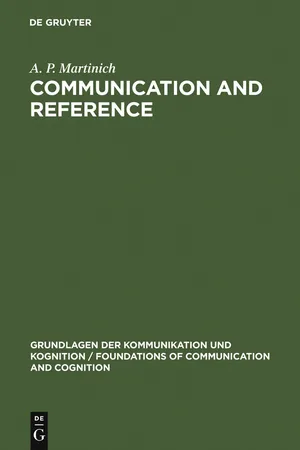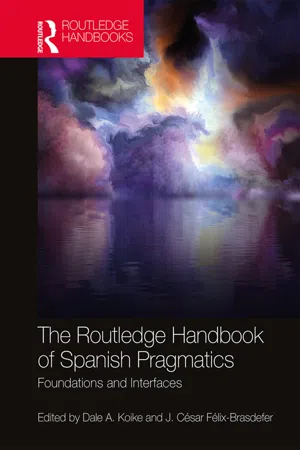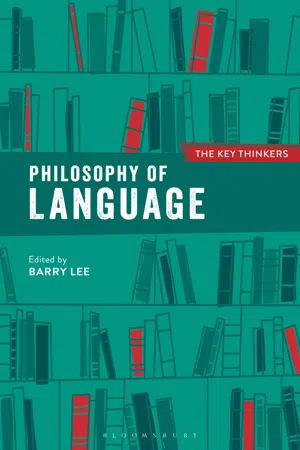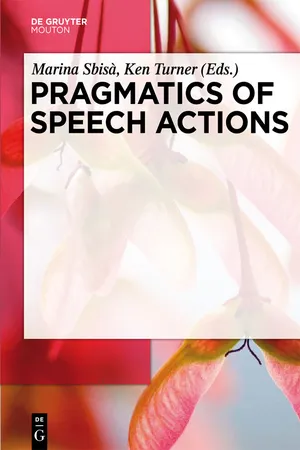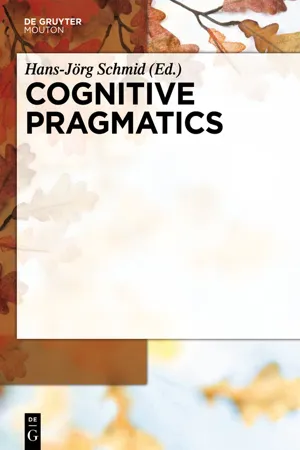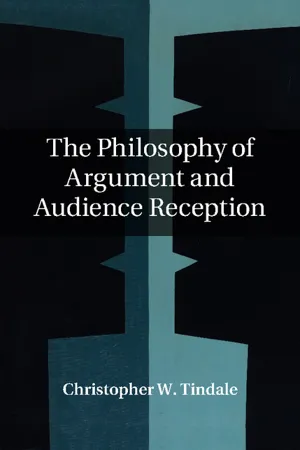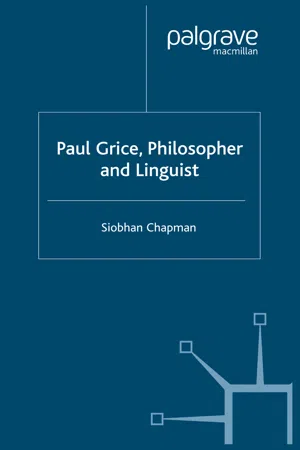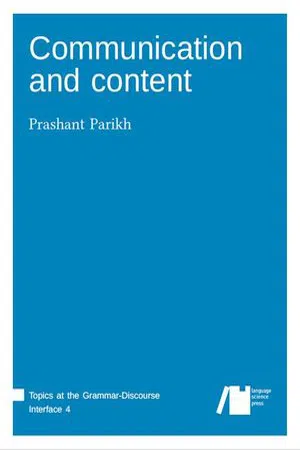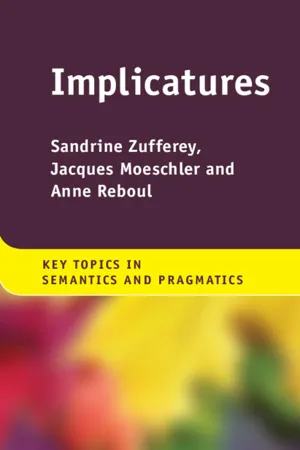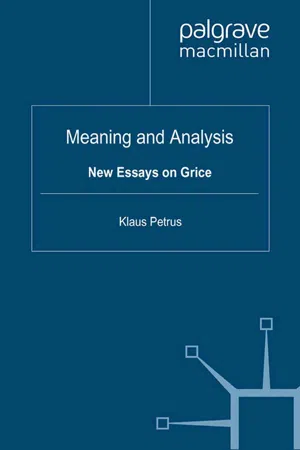Languages & Linguistics
Grice's Conversational Maxims
Grice's Conversational Maxims are a set of four principles that guide effective communication: maxim of quantity (be as informative as necessary), maxim of quality (be truthful), maxim of relation (be relevant), and maxim of manner (be clear and avoid ambiguity). These maxims help to explain how people interpret and produce meaningful utterances in conversation.
Written by Perlego with AI-assistance
Related key terms
1 of 5
12 Key excerpts on "Grice's Conversational Maxims"
- eBook - PDF
- A. P. Martinich(Author)
- 2012(Publication Date)
- De Gruyter(Publisher)
In order to understand the structure of conversation, we need to know what specific rules the participants ob-serve. Grice mentions a number of rules of this sort, which he calls Con-versational Maxims and sets out in four groups: There are maxims of quantity, maxims of quality, maxims of relation, and maxims of manner. (The term 'maxim' is borrowed from Immanuel Kant's theory of morals; the grouping of the maxims into categories of Quantity, Quality, Relation, and Manner is an adaptation, or perhaps a parody, of Kant's division of the concepts of pure reason in his Critique of Pure Reason. Needless to say, the value of the distinction is entirely stylistic and mnemonic; it bears no theo-retical weight whatever.) Here is Grice's list of maxims. Quantity A1. Make your contribution as informative as required (for the current pur-poses of the exchange) A2. Do not make your contribution more informative than is required. Quality B. Try to make your contribution one that is true. B l . Do not say what you believe to be false. Β2. Do not say that for which you lack adequate evidence. Relation C. Be relevant. Manner D. Be perspicuous. D l . Avoid obscurity of expression. D2. Avoid ambiguity. D3. Be brief (avoid unnecessary prolixity). D4. Be orderly. (Grice (1975), p. 46). The next four sections contain explanation and critical discussion of these maxims. 3 22 Communication IV. Maxims of Quantity As an illustration of the maxims of quantity, consider the following situa-tion. Professor Wisdom is the college advisor of student Precocious, and on one occasion he needs to know whether Precocious has accumulated credit enough to be counted as a senior (perhaps because there are some courses that only seniors can take). - eBook - ePub
The Routledge Handbook of Spanish Pragmatics
Foundations and Interfaces
- Dale A. Koike, J. Cesar Felix-Brasdefer, Dale A. Koike, J. Cesar Felix-Brasdefer(Authors)
- 2020(Publication Date)
- Routledge(Publisher)
The Cooperative Principle (henceforward, the CP) captures the idea that speakers generally try to make their utterances appropriate to the conversational context, since otherwise, successful conversations would be impossible. In other words, felicitous conversations rely on the assumption that interlocutors intend to be cooperative and, according to Grice, speakers implicate messages by exploiting this assumption. He instantiates the CP via four categories of conversational maxims, three of which have sub-maxims (1975, pp. 45–46):-
(5) Quantity:
- Make your contribution as informative as is required (for the current purposes of the exchange).
- Do not make your contribution more informative than is required.
- Do not say what you believe to be false.
- Do not say that for which you lack evidence.
- Avoid obscurity of expression.
- Avoid ambiguity.
- Be brief.
- Be orderly.
Grice’s maxims are principles speakers generally follow and expect others to follow, which together, spell out the CP. The Quantity sub-maxims account for our assumption that speakers should be no more or less informative than necessary. The Quality sub-maxims capture our expectation that speakers will not make specious or unfounded statements, while Relation (also called the ‘Relevance maxim’) captures the assumption that speakers will contribute relevantly to conversations, just as we would offer ibuprofen for a headache and not a band-aid. Finally, the Manner maxim does not concern how much information is conveyed, but rather how speakers express intended meanings via more usual, simpler, clearer, and oftentimes shorter expressions (e.g., casa ‘house’), versus less usual, prolix or obscure, and thus marked expressions (e.g., residencia - eBook - PDF
- Herman Parret(Author)
- 2012(Publication Date)
- De Gruyter(Publisher)
What is the nature of Grice's CP and the maxims? Levinson sees it as essentially a theory about how people use language (1983,102) efficiently and effectively in conversation. His view can be referred to as a rhetorical interpretation of Grice. An explicit spokesman of rhetorical interpretation is Marpurgo-Tagliabue who argues that all the Gricean maxims are classical Pragmatics and Rhetoric: A Collaborative Approach to Conversation 177 rhetorical rules in disguise: Grice ... proposes nothing else than the rules of classical rhetoric adapted to the modern position of speech ... - eBook - ePub
- Barry Lee(Author)
- 2019(Publication Date)
- Bloomsbury Academic(Publisher)
h earer). If taking the utterance at face value is incompatible with this presumption, the hearer, still relying on this presumption, must find some plausible candidate for what else the speaker could have meant. In the above example, where the speaker is asked to evaluate a certain dinner, he must figure out what she meant, relying on the presumption that she intended it to be an accurate, informative and appropriate answer to the question. In effect what the hearer does is, on the presumption that the speaker is being cooperative, to find a plausible explanation for why she said what she said.3.1 The Cooperative Principle and the maxims of conversationGrice codified these ideas by formulating an overarching Cooperative Principle and four sets of subordinate maxims of conversation (Grice, 1975 /1989 , pp. 26–7):COOPERATIVE PRINCIPLE: Make your conversational contribution such as is required, at the stage at which it occurs, by the accepted purpose or direction of the conversational exchange. QUALITY: Try to make your contribution one that is true.QUANTITY:1. Do not say what you believe to be false.2. Do not say that for which you lack evidence.RELATION: Be relevant. MANNER: Be perspicuous.1. Make your contribution as informative as is required (for the current purposes of the exchange).2. Do not make your contribution more informative than is required.1. Avoid obscurity of expression.2. Avoid ambiguity.3. Be brief. (Avoid unnecessary prolixity.)4. Be orderly.We could dwell on the precise meanings of these maxims, on whether they are adequately formulated, and on whether the list can be simplified (for discussion see Harnish, 1976 - eBook - PDF
- Marina Sbisà, Ken Turner, Marina Sbisà, Ken Turner(Authors)
- 2013(Publication Date)
- De Gruyter Mouton(Publisher)
In order to understand the speaker’s meaning, A is guided by certain expectations concerning S’s behaviour: namely the expec-tation that S’s utterance will satisfy certain standards – being informative, sincere, relevant and clear. The Cooperative Principle is specified by four categories, called Quantity, Quality, Relation and Manner, under which fall more specific maxims. The Quantity Maxims reflect the expectation that speakers are reasonably in-formative: 1. Make your contribution as informative as is required (for the current purposes of the exchange). 2. Do not make your contribution more informative than is required. The Quality Maxims reflect the expectation that speakers are sincere and justified in their utterances; there is a supermaxim “Try to make your contribution one that is true” and two maxims: 1. Do not say what you believe to be false. 2. Do not say that for which you lack adequate evidence. The Relation Maxim reflects the expectation that speakers are relevant: “Be rel-evant”. 4 The Manner Maxims reflect the expectation that speakers are clear: “Be per-spicuous”: 1. Avoid obscurity of expression. 2. Avoid ambiguity. 3. Be brief (avoid unnecessary prolixity). 4. Be orderly (Grice 1989e: 26–27). Conversational maxims “are such that, in paradigmatic cases, their observance promotes and their violation dispromotes conversational rationality” (Grice 1989a: 370); but they have the interesting feature of being effective even when they are violated. As a matter of fact, speakers sometimes “flout” the maxims – i.e. violate the maxims intentionally and overtly: the addressee will then try to reconcile the violations with the assumption that speakers are generally cooperative. Cases of blatant violation typically give rise to conversational implicatures: a maxim is then exploited in order to obtain particular communicative effects and more specifically in order to convey an additional proposition. - eBook - PDF
- Hans-Jörg Schmid(Author)
- 2012(Publication Date)
- De Gruyter Mouton(Publisher)
Conversational and conventional implicatures 411 Section 5 is devoted to his theory of implicature, which is a development of his the-ory of meaning NN . 5. Grice’s logic of conversation Grice’s logic of conversation is based on the idea that contributors to a conver-sation are rational agents; that is, that they obey a general principle of rationality known as the “cooperative principle” (CP). This principle is formulated as follows (Grice 1975: 45): “Make your conversational contribution such as is required, at the stage at which it occurs, by the accepted purpose or direction of the talk ex-change in which you are engaged”. In order to fulfil the cooperative principle, the speaker must follow nine maxims of conversation, grouped in four Kantian cat-egories: Quantity, Quality, Relation and Manner. Grice’s definitions of these maxims are as follows (Grice 1975: 45–46): Gricean maxims of conversation Maxims of Quantity: 1. Make your contribution as informative as is required. 2. Do not make your contribution more informative than is required. Maxims of Quantity: Try to make your contribution one that is true. 1. Do not say what you believe to be false. 2. Do not say that for which you lack ad-equate evidence. Maxim of Relation: Be relevant. Maxims of Manner: Be perspicuous. 1. Avoid obscurity of expression. 2. Avoid ambiguity. 3. Be brief. 4. Be orderly. What is the connection between the CP and the maxims? First, the speaker is able to fulfil the maxims, or at least some of them. 4 The default case occurs when the maxims of quality, relation and manner are satisfied. For instance, as an illustration of the sub-maxim of manner “be orderly”, the interpretation of (11a) will not be exactly the same as the interpretation of (11b): (11) a. Paul and Mary got married, lived happily and had four children . b. Paul and Mary had four children, lived happily, and got married . - Christopher W. Tindale(Author)
- 2015(Publication Date)
- Cambridge University Press(Publisher)
Such a principle, and its maxims, can be violated, rejected, impeded, or flouted, depending upon the circumstances involved, such as the goals of a speaker and her available resources (she may not be able to be informative, for example, without saying what she lacks the evidence to say, and so her ability to obey the first maxim of Quantity is impeded). And it is these “failures” to meet the maxims that complete the basic account leading to the full characterization of “conversational implicature.” A person has conversationally implicated q in the saying of p on the understanding that “(1) he is presumed to be observing the conversational maxims, or at least the Cooperative Principle, (2) the supposition that he is aware that, or thinks that, q is required in order to make his saying or making as if to say p (or doing so in those terms) consistent with this presumption; and (3) the speaker thinks (and would expect the hearer to 6.3 Revising Grice 105 think that the speaker thinks) that it is within the competence of the hearer to work out, or grasp intuitively, that the supposition mentioned in (2) is required” (30–31). A conversational implicature, then, aims to be informative, truthful, relevant, and clear. It is used in order to say p along these lines (later, Grice tells us such implicatures are non-detachable, there being no other way of saying the same thing), and is intended by the speaker to be understood by the hearer and to be understood as so intended. 6.3 Revising Grice Grice’s ideas did much to clarify the distinction between semantics and pragmatics, but the idea of implicatures has had its critics; at least with respect to the claims Grice makes. Laurence Horn (1984; 2005), for example, reduces the conversational implicature maxims to two – a Q Principle (QP) and an R Principle (RP). The QP is hearer based, and the RP speaker based. The Q-based implicatures are founded on the principle “Say enough”; a generalization of Grice’s first maxim of quantity.- eBook - PDF
Paul Grice
Philosopher and Linguist
- S. Chapman(Author)
- 2005(Publication Date)
- Palgrave Macmillan(Publisher)
Further, speakers are reluctant to commit themselves explicitly to particular claims, and therefore to take on responsibility for the reliability of the information. For these reasons, the expectations about conversational practice and the implicatures following from particular utterances are different from those assumed by Grice to be universal norms. Keenan complains that ‘the conversational maxims are not presented as working hypotheses but as social facts’ and argues that much more empirical work on conversation must be conducted before true para- digms of conversational practice can be drawn up. 64 Her criticism, then, is chiefly the familiar one that Grice has attempted to describe ‘con- versation’ without having considered the mechanics of any actual con- versation, with the added claim that such a consideration would reveal some significant variations between cultures. However, she welcomes Grice’s attempt to posit universal conversational principles, because of 198 Paul Grice, Philosopher and Linguist the possibility it suggests for those engaged in fieldwork to move away from specific empirical observations ‘and to propose stronger hypo- theses related to general principles of conversation’. 65 She suggests that the particular maxims may apply in different domains and to different degrees in different societies. In Malagasy society, determining factors include the importance of the information in question, the degree of intimacy between the participants, and the sex of the speaker. A number of linguists have defended Grice against Keenan’s accusation. Georgia Green has suggested that even the discovery that a particular maxim did not apply at all in one society would not invalidate Grice’s general enterprise. Since the maxims are individual ‘special cases’ of coopera- tion, ‘discovering that one of the maxims was not universal would not invalidate claims that the Co-operative Principle was universal’. - eBook - PDF
- Prashant Parikh(Author)
- 2019(Publication Date)
- Language Science Press(Publisher)
In o ther words, the Gricean maxims are completely superfuous. 17 As we will see, however, the Cooperative Principle is required. Grice’s theory of conversation also assumed the pipeline theory of meaning where the syntax of the sentence u tered is de termined frst, then its semantics (i.e. its literal meaning), and fnally its pragmatics (i.e. its implicatures). Te im-plicatures were derived from the literal meaning and other facts of the u terance. As I have shown earlier, 18 literal meaning and implicature can in fact be interde-pendent as all meanings tend to be. Tis two-way infuence will be discussed in detail in Part IV. I will show, in fact, that not only are the various meanings of an uterance in terdependent but so are these meanings and the optimal parse of the u terance. In o ther words, the implicature can depend in part on the optimal parse and vice versa. To conclude this section, I point out that the Gricean theory of conversation is really a theory of interpretation and not communication. While it is two-sided, it has litle to say about the speaker’s calculations. It also ofers nothing about how literal meaning is to be derived and one is forced to surmise that Grice probably meant this to be addressed by convention. While conventional meaning does play an important role in the determination of literal meaning, the process is ineluctably contextual as I have shown before and will show in even greater detail in this book. 5.3 Speaker meaning and word meaning As I said toward the end of Section 3.1, Grice wanted to reduce the intentionality of language, its aboutness or acquisition of meaning, to the intentions and beliefs of speakers, with the idea that these mental states could be further reduced to physical facts. Tis would explain how meaning could be part of the natural order. In his view, the key notion to efect such a reduction was that o f speaker meaning. - eBook - PDF
- Sandrine Zufferey, Jacques Moeschler, Anne Reboul(Authors)
- 2019(Publication Date)
- Cambridge University Press(Publisher)
Grice proposed a logic of conversation to account for how the speaker’s intentions are recovered. This logic of conversation is based on a principle that any rational speaker should respect, the Cooperative Principle, itself detailed in four maxims, Quantity, Quality, Relation and Manner. In cases where the speaker seems to have flouted the Cooperative Principle, the hearer reasons from the assumption that she respected it to come up with an alternative interpretation that shows that she indeed complied with it. Implicatures are of two sorts: conventional implicatures, which are automatically triggered by a lexical item in the utterance, and conversational implicatures. Conversational implicatures can only be recovered through the mechanism just described. In many cases, they are derived from considering not only the utterance that the speaker actually produced, but also the alternative utterances that the speaker might have produced. Depending on how these alternative utterances THEORETICAL FOUNDATIONS 20 20 are determined, i.e. through the lexicon or through the context, Grice distinguished between, respectively, generalized conversational implicatures (which are not context dependent) and particularized conversational implicatures (which are context dependent). Grice also indicated a range of properties that differentiate implicatures from explicitly communicated meaning and also serve to distinguish between the different types of implicature. Conversational implicatures must be calculable, cancellable and reinforcable. Generalized conversational implicatures are context inde- pendent, while particularized conversational implicatures are con- text dependent. Finally, Grice insisted on the very existence of the cooperative assumption (the assumption that the speaker complies with the Cooperative Principle), determinacy and common know- ledge, in the so-called Generative Assumption. - eBook - PDF
- Richard Breheny, K. Petrus, Uli Sauerland, K. Petrus, Uli Sauerland(Authors)
- 2010(Publication Date)
- Palgrave Macmillan(Publisher)
Grice’s theory of conversation is part of his theory of language, which in turn belongs to the philosophy of language. He conceives of the philoso- phy of language as a domain of rational psychology which for its part belongs to philosophical psychology . All these areas are finally to be located within ‘first philosophy’, i.e. metaphysics. Given that these domains all together revolve around human rationality, it is a matter of consequence that they are dealing with aspects of this subject in an increasingly specialized man- ner. The theory of conversation is such a sub-branch; its topic is linguistic behaviour insofar as it can be interpreted as rational behaviour. Nevertheless, it should not be forgotten that the theory of conversation has another side too. As explained in section 3.2, it is essential to Grice’ s understanding of conceptual analysis to clearly distinguish between the meaning of an expression and other facets of its use. It is exactly this very purpose the theory of conversation has to serve as a methodological tool: to prevent that meaning and use are telquel identified. In his ‘Reply to Richards’ Grice notes the following: In my own case, a further impetus towards a demand for the provision of a visible theory underlying ordinary discourse came from my work on the idea of Conversational Implicature, which emphasized the radi- cal importance of distinguishing (to speak loosely) what our words say or imply from what we in uttering them imply; a distinction seemingly denied by Wittgenstein, and all too frequently ignored by Austin. (Grice 1986: 59, his emphasis) Hence Grice’s theory of conversation has two sides: as a philosophical domain it covers a certain domain of a general theory of rationality; its topic is rational linguistic behaviour. And in methodological respects it serves as an instrument for the distinction between meaning and use. 6. Meaning and rationality Like the theory of conversation, Grice’s account of meaning has its two sides. - eBook - PDF
Reviewing Linguistic Thought
Converging Trends for the 21st Century
- Sophia Marmaridou, Kiki Nikiforidou, Eleni Antonopoulou, Sophia Marmaridou, Kiki Nikiforidou, Eleni Antonopoulou(Authors)
- 2011(Publication Date)
- De Gruyter Mouton(Publisher)
The consequences of the above-mentioned assumptions appear perhaps most explicitly in Gricean pragmatics and its offshoots. As is well known, Grice's Cooperative Principle (CP) states: Make your conversational contribution such as is required, at the stage at which it occurs, by the accepted purpose or direction of the talk exchange in which you are engaged. (Grice 1989: 26) As known, this principle does not claim that language users are in fact al-ways cooperative, but rather that -other things being equal -they interpret each other's utterances as if they were. Most modestly, this principle merely captures an allegedly neutral or normal way of speaking. Even in such terms, the presumption that there is such a thing as a stylistically or socially neutral form of conversation, which is then characterized in the decidedly non-neutral terms of cooperativeness, politeness, and equality among the participants, runs into trouble. In many Gricean-inspired ap-proaches, however, an overarching principle of cooperation becomes some-thing much more momentous: it is no longer seen as merely a guiding prin-ciple governing the interpretation of polite exchanges of information, but as something of a necessity of nature: in Relevance Theory, something closely resembling the Cooperative Principle is promoted to the quasi-naturalistic status of a general empirical principle of human cognition; and there have recently been calls to turn the Principle into a central notion for logical se-mantics, that is, into a logical, or a priori, principle (Groenendijk 1999). Such moves mask the fact that this principle is by no means as universally present or presumed in communication as is often held. Clearly, the Cooperative Principle has proved a rich and successful tool in linguistic theorizing. Yet, there are various kinds of linguistic interaction that do not conform to it.
Index pages curate the most relevant extracts from our library of academic textbooks. They’ve been created using an in-house natural language model (NLM), each adding context and meaning to key research topics.
